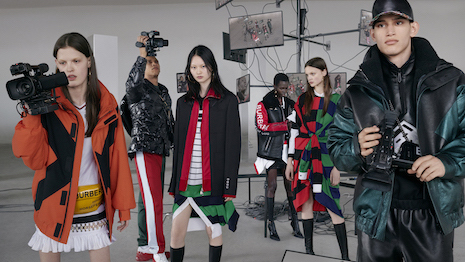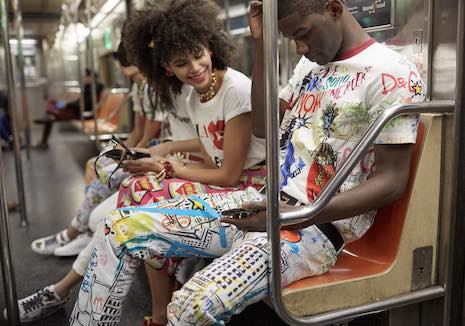 Every consumer is now an influencer. Image credit: Burberry
Every consumer is now an influencer. Image credit: Burberry
Heritage brands need to modernize to reach the up-and-coming Gen Z audience, since this consumer cares more about being up-to-date on present trends than the past.
A report conducted by Sunshine and Walpole finds that while 16 to 24 year olds represent about 21 percent of the U.S., they make up 16 percent of those interested in luxury. While Gen Z might not yet have the buying power that older consumers have, Walpole executives stressed the importance of connecting with them early.
"You’ve got to start young, almost before people are in the purchase cycle," said Helen Brocklebank, CEO of Walpole. "And that’s always been the case, if you think of the power of print 20 to 30 years ago.
"But if you look at Harrods' beauty hall, where a lipstick is about 25 pounds, anybody can have a piece of luxury there, but it also creates an Instagrammable moment," she said.
The report is based on conversations with 4,600 consumers, comparing Gen Z with older luxury cohorts.
Up-and-coming consumers
By 2025, Gen Z and millennials are expected to make up 45 percent of the luxury market, according to Bain.
Gen Zers are more apt than older generations to take sustainability into account, be trendsetters and seek out experiences. Luxury brands therefore need to take on more contemporary approaches to cater to shifting psychographics and behavior.
Despite being the same age and sharing certain attributes, Gen Z is not homogenous, as these consumers fit varying profiles.
One in five Gen Z consumers are “High Stylists,” compared to just 10 percent of the overall population of luxury shoppers. Forty percent of this segment strong agree that friends often turn to them for advice on new fashion buys, and 45 percent believe that their network would deem them stylish.
 According to Walpole execs, Dolce & Gabbana has succeeded at creating a cross-generational appeal. Image credit: Dolce & Gabbana
This segment also shows a strong affinity for high-end fashion, with 41 percent saying that most items they wear are designer.
For this group, a brand’s story is important, but the report notes that they are more concerned with being stylish and finding the new, calling for brands to stay contemporary and relevant.
While sustainability is an important factor that Gen Z consumers consider, for most of this age group, a brand’s eco credentials are not the primary purchase driver.
The exception is a customer type that the report calls “Sustainable Idealists,” 26 percent of whom are Gen Z. This group represents 5 percent of all luxury customers and 9 percent of Gen Z.
Among this customer profile, 36 percent agree that it is vital for brands to be sustainable.
This group also shows less of an affinity and means for luxury. Fifteen percent of Sustainable Idealists say that experiences are more important to them than acquisitions.
Gen Z is also more largely represented in “Experimentalists,” who heavily value culture such as music. Fourteen percent of luxury customers fit this profile, and 17 percent of Gen Zers are considered Experimentalists.
Forty-eight percent of this group say that they are individualistic. This plays out in how they shop, with 43 percent saying they buy new fashion when it speaks to them and 41 percent enjoying experimenting with new trends and their personal style.
“Aspirational Admirers” are equally represented in the Gen Z and broader luxury consumer base, with 16 percent of the audience.
This group has a desire for luxury goods but not necessarily the means to purchase, with 42 percent saying that they would spend a lot more on luxury if they could afford it. However, this group is important in building cachet around brands as social media followers and participants.
Aspirational Admirers are also willing to save up to occasionally splurge on luxury.
Gen Z is also open to digital ownership, which brands are warming up to. For instance, Burberry’s recent B Bounce game enables shoppers to virtually wear its parkas, while Louis Vuitton teamed with League of Legends to offer players purchasable skins for their characters (see story).
Drest app
This is also extending to fashion-centric experiences. Interactive styling game Drest enables shoppers to play with fashion brands such as Gucci and even buy items.
New consumption
Across all mass luxury consumers, 61 percent say they are more interested in amassing experiences rather than possessions.
Generations Y and Z will account for 130 percent of luxury market growth through 2025, but brands need to stay cognizant that these consumers have evolving views of ownership.
According to the 10th annual ForwardPMX Luxury Study, nearly all luxury purchases will be influenced by online interactions by 2025, whether transactions are completed online or in-store. Resale sites are also becoming more popular among luxury consumers, demonstrating that accessibility is also driving luxury growth (see story).
Despite being digitally driven, Generation Z consumers value bricks-and-mortar shopping and tactile retail experiences.
A report from Criteo finds that while three-quarters of this up-and-coming consumer group prefer to shop online, 80 percent enjoy visiting physical stores when possible and 65 percent want to touch items before buying. Rather than eschewing traditional retail entirely for ecommerce, Gen Z is instead seeking bricks-and-mortar stores that incorporate technology and seamless omnichannel shopping (see story).
"Everybody believed that Gen Z was going to move away from brands," said Michael Ward, chairman of Walpole and managing director of Harrods. "And what it clearly says is brands are one of the most important things for that generation.
"So all of these sort of prophets of doom yet again are wrong, because they missed one fundamental fact – that luxury brands produce stunningly beautiful product, which whatever generation you sit in, you just want," he said. "That’s the bit that everybody misses.
"From a retail perspective for us, it’s really easy: put beautiful things in beautiful locations and give amazing service, and actually you’ve won."
According to Walpole execs, Dolce & Gabbana has succeeded at creating a cross-generational appeal. Image credit: Dolce & Gabbana
This segment also shows a strong affinity for high-end fashion, with 41 percent saying that most items they wear are designer.
For this group, a brand’s story is important, but the report notes that they are more concerned with being stylish and finding the new, calling for brands to stay contemporary and relevant.
While sustainability is an important factor that Gen Z consumers consider, for most of this age group, a brand’s eco credentials are not the primary purchase driver.
The exception is a customer type that the report calls “Sustainable Idealists,” 26 percent of whom are Gen Z. This group represents 5 percent of all luxury customers and 9 percent of Gen Z.
Among this customer profile, 36 percent agree that it is vital for brands to be sustainable.
This group also shows less of an affinity and means for luxury. Fifteen percent of Sustainable Idealists say that experiences are more important to them than acquisitions.
Gen Z is also more largely represented in “Experimentalists,” who heavily value culture such as music. Fourteen percent of luxury customers fit this profile, and 17 percent of Gen Zers are considered Experimentalists.
Forty-eight percent of this group say that they are individualistic. This plays out in how they shop, with 43 percent saying they buy new fashion when it speaks to them and 41 percent enjoying experimenting with new trends and their personal style.
“Aspirational Admirers” are equally represented in the Gen Z and broader luxury consumer base, with 16 percent of the audience.
This group has a desire for luxury goods but not necessarily the means to purchase, with 42 percent saying that they would spend a lot more on luxury if they could afford it. However, this group is important in building cachet around brands as social media followers and participants.
Aspirational Admirers are also willing to save up to occasionally splurge on luxury.
Gen Z is also open to digital ownership, which brands are warming up to. For instance, Burberry’s recent B Bounce game enables shoppers to virtually wear its parkas, while Louis Vuitton teamed with League of Legends to offer players purchasable skins for their characters (see story).
Drest app
This is also extending to fashion-centric experiences. Interactive styling game Drest enables shoppers to play with fashion brands such as Gucci and even buy items.
New consumption
Across all mass luxury consumers, 61 percent say they are more interested in amassing experiences rather than possessions.
Generations Y and Z will account for 130 percent of luxury market growth through 2025, but brands need to stay cognizant that these consumers have evolving views of ownership.
According to the 10th annual ForwardPMX Luxury Study, nearly all luxury purchases will be influenced by online interactions by 2025, whether transactions are completed online or in-store. Resale sites are also becoming more popular among luxury consumers, demonstrating that accessibility is also driving luxury growth (see story).
Despite being digitally driven, Generation Z consumers value bricks-and-mortar shopping and tactile retail experiences.
A report from Criteo finds that while three-quarters of this up-and-coming consumer group prefer to shop online, 80 percent enjoy visiting physical stores when possible and 65 percent want to touch items before buying. Rather than eschewing traditional retail entirely for ecommerce, Gen Z is instead seeking bricks-and-mortar stores that incorporate technology and seamless omnichannel shopping (see story).
"Everybody believed that Gen Z was going to move away from brands," said Michael Ward, chairman of Walpole and managing director of Harrods. "And what it clearly says is brands are one of the most important things for that generation.
"So all of these sort of prophets of doom yet again are wrong, because they missed one fundamental fact – that luxury brands produce stunningly beautiful product, which whatever generation you sit in, you just want," he said. "That’s the bit that everybody misses.
"From a retail perspective for us, it’s really easy: put beautiful things in beautiful locations and give amazing service, and actually you’ve won."
